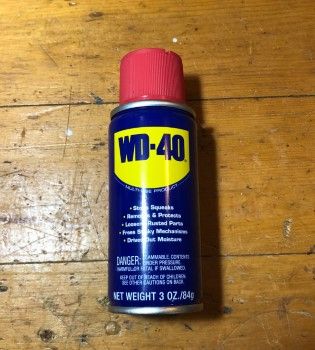What to do with WD-40
WD-40 is freaking awesome! Learn a few of its superpowers and uses.

The back story
WD-40 is one of those products that seem possessed of magical properties. These allow the product to be used in ways the developers never in their wildest imagination envisioned.
The WD in WD-40 stands for water dispersant. The developers were looking for a product that could be applied to metal surfaces that would prevent water (and rust) from forming. The 40 reflects the 40th formula tried that performed the functions they sought. Thomas Edison would be proud! He failed around 3,000 times in his effort to perfect the incandescent light bulb.
Warning, tangent approaching!
When you think of incandescent bulbs, fragility and short life-spans likely come to mind. Well, there is one that has been in nearly continuous operations since 1901. Called the Centennial Light, it is located in a Livermore-Pleasanton Fire Department facility.
Would you believe 2,000 uses?
There, I got that out of my system. So, how many things can you use WD-40 for around the house? According to the WD-40 website, there are over 2,000 documented uses for their magic elixir. You can download a PDF of the list for future reference.
If you don't have time to sort through 2,000+ applications, WD-40 has provided a Top 10 list. My favorite from the list is #2 - you can use it to remove duct tape, the second foundation item in the perfect tool kit.
What have I used WD-40 for in my projects? I'll admit to a pedestrian, non-adventurous history with the product. Here are my top three:
- Silence squeaking hinges
- Loosening rusted screws and nuts
- Lubricating water shut off valves before turning them
This last application comes with a short tale. For years, when I needed to work on a faucet or turn off the outside hose bib for winter, I simply went to the valve and cut it off. One day while talking with my Dad, he asked if I sprayed WD-40 on the valve shaft before I turned it. I said no, and he replied that if I didn't, the valve would leak.
That had never been my experience, so I tucked the info aside. You can guess what happens. The very next time I needed to operate a valve, I did it without the WD-40 treatment. The valve started leaking!
Here's the rationale behind using WD-40 this way, the valve shaft runs through a gasket/washer that prevents leaks. Over time, if it isn't used, the gasket dries out. The next time the valve is operated, a leak develops. Spraying WD-40 beforehand lubricates the gasket and prevents leaks.
Application tips
While talking about the application of WD-40 may seem unnecessary, there are some lessons learned to share.
Each new can of WD-40 comes with a little red straw that fits into the spray nozzle. This straw allows you to add your Wd-40 with pinpoint precision. It works like a charm. Unfortunately, these handy little accessories tend to go missing. There is a wormhole somewhere just chock full of red WD-40 straws.
Applying WD-40 without the straw is messier. So, tip #1 is to hold a paper towel under the area you are spraying to catch excess product. If you happen to be working on a stainless steel appliance like I was recently, use the WD-40 enriched towel to clean the stainless steel surface.
Tip #2 is to move the thing you are spraying. This applies most commonly to hinges but also to other situations. Spray, move the part, repeat. If you are getting rid of a squeak, it may take a couple of spritzes to quiet the noise. It may also require letting the WD-40 work its magic. Let it sit for a few hours and check to see if the squeak is gone.
